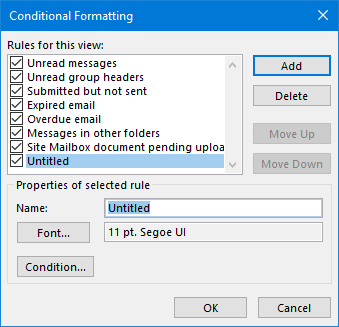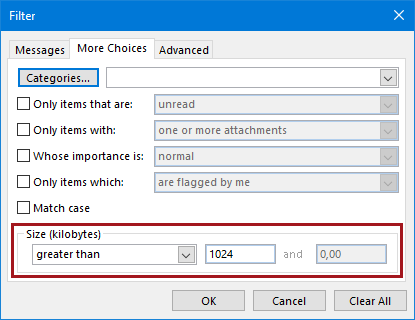
Outlook comes with its own themes independent from Windows, but more about that later. If you prefer a different font size, you can click on the “Set Custom text size (DPI)” on the left and type any percentage you like. You can now directly choose to make the fonts larger.
#How to make outlook conditional formatting for all folders windows

Especially TFT/LCD-screens are designed to be ran in their highest resolution. The solution is not to decrease your resolution settings as that will leave you with a less sharper image. The higher your resolution settings, the smaller your letters will become. Modifying the size of the general interface, and thus also the font, is quite popular these days with monitors capable of very high resolutions. By modifying the settings at Windows level, you change all the settings for all the applications (that respect the Windows settings) at once so you don’t have to change it for each individual application. We begin with the settings at Windows since chances are that if you don’t like the general font and color settings in Outlook, you probably don’t like them in other applications either. This guide provides an overview how you can change which section of Outlook and if it needs to be done at Outlook level or at Windows level.Īre you looking for a method to give Outlook 2013, 2016 or 2019 a more “classic” look? Then see: Making the Outlook 2013 interface less white and bright.

Some sections can even be modified in multiple ways to reach the same or similar results. Most of them can be changed but the way to do it is scattered between various Windows and Outlook settings and even then they are not in a single location. then Automatic Formatting button.If you don’t like the way Outlook looks like by default, you might want to find out how you can change the fonts types, sizes and colors in Outlook to suit your taste better. Video tutorial: Outlook 2010 and newerĬlick on Arrange By to expand the menu and select Custom. To make a copy of the view, choose Save Current view as a New View from the Change View menu. If the original view gets messed up, use the copy and apply it to the folders. You can make a copy of the view thus is recommended if you customized a default view as it's very easy to accidently reset the view. To apply it to other folders, use Change View > Apply Current View to Other Mail Folders to set the view on other folders. Close the dialogs and apply the view when finished.īecause Conditional formatting is part of a view, it may only be applied to the current folder (or to folders using the current view).In this example, I'm going to highlight all messages from. Do not use the From field on the Advanced tab. If you want to filter by email address, not display name, type the address or part of the address in the From field on the Messages tab. Click Add and enter a name for the formatting rule choose your Font.Click Conditional Formatting button (it's called Automatic Formatting in older versions of Outlook.).In all versions, right click on the row of field name (or Arrange By) at the top of the message list and choose Customize (or View Settings). In Outlook 2010 and newer, look for the View Settings button on the View tab.

In this example, I'm highlighting messages from a sender in Red then creating a copy of the view so I can show only the messages from that sender.


 0 kommentar(er)
0 kommentar(er)
